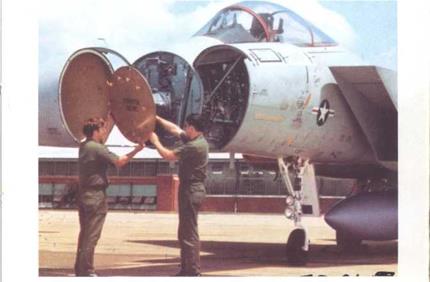McDonnell Douglas F-15 Eagle
F-15A, F-15B, F-15C, F-15D
Origin: McDonnell Aircraft, division of McDonnell Douglas Corp, St Louis, USA.
Type: Single-seat all-weather air-superiority fighter: (TF) dual-control trainer.
Engines: Two Pratt & Whitney F100-100 two-shaft augmented turbofans, each rated at 14,8711b (6744kg) thrust dry and 23,8101b (10,800kg) with maximum augmentation.
Dimensions: Span 42ft 9|in (13-05m); length 63ft 9jin (19-46m): height 18ft 7iin (5-68m).
Weights: Empty, about 28,000lb (12,700kg): loaded (F or TF, clean) 39,500lb: (F with four Sparrows) about 40,500lb, (three 600gal drop tanks) 54,000lb, (three tanks and two FAST packs) 66,000lb (29,937kg) Performance: Maximum speed (low) over 921 mph (1482km/h, Mach 1-22), (high) over 1.650mph (2660km/h. Mach 2-5): initial climb, over 50,000ft (1 5,240m)/min: service ceiling, over 70,000ft (21,000m): range on internal fuel, about 1,200 miles (1930km): ferry range with maximum fuel, over 3,700 miles (5955km).
Armament: One 20mm M-61 multi-barrel gun with 960 rounds: four AIM-7 Sparrow air-to-air missiles on corners of fuselage and four AIM-9 ■Sidewinder air-to-air missiles on lateral rails at upper level of wing pylons: centreline pylon stressed for 4,5001b (2041kg) for 600 gal tank, reconnaissance pod or any tactical weapon: inner wing pylons stressed for 5,1001b (2313kg) for any tanks or weapon: outer wing pylons stressed for 1,0001b (454kg) for ECM pods or equivalent ordnance load. Normal external load limit, with or without FAST packs, 12,0001b (5443kg).
History: First flight 27 July 1972: (TF) 7 July 1973: service delivery March 1974 (Cat. II test), November 1974 (inventory).
Users: Israel, Japan, Saudi Arabia, USA (Air Force).
Development: Emergence of the MiG-23 and -25 in 1 967 accentuated the belief of the US Air Force that it was falling behind in true fighter aircraft. Studies for an FX (a new air-superiority fighter) were hastened and, after a^
|
|
 |
 |
Above: Examining the flat-plate antenna of the APG-63 radar.
Left: Landing gears begin to extend from an F-15A of the Heyl Ha’Avir (Israeli air force) carrying neither missiles nor tanks.
Below: Peel-off for landing by Eagles of the 1st Tactical Fighter Wing USAF at Langley AFB, Virginia (note TAC tail badges).
|
|

These USAF Eagles on detachment to an Arctic base were among the first to be seen with the painted radome which, after prolonged research, is now becoming standard. Low-visibility paint is now used over almost the entire aircraft, the problems with the radome including resistance to erosion by rain and hail, proper adhesion to a slightly flexible surface and avoidance of any degradation of radar performance. It is probable that similar coatings will become standard on other interceptors including RAF Phantoms.
|
|
major competition. McDonnell’s team at St Louis was selected to build the new aircraft. The Air Force funded a new engine, won by Pratt & Whitney, and a new 25mm gun using caseless ammunition (abandoned after difficult development). The Eagle has emerged as probably the best fighter in the world, with thrust at low levels considerably greater than clean gross weight, a fixed wing of no less than 530 sq ft area, a single seat and an advanced Hughes X-band pulse-doppler radar. Though planned as an uncompromised machine for interception and air combat the Eagle also has formidable attack capability over intercontinental ranges. Undoubtedly its chief attributes are its combat manoeuvrability (it can outfly almost any other US machine without using afterburner) and the advanced automaticity of its radar, head-up display, weapon selectors and quick-fire capability. Internal fuel capacity of 11,2001b can be almost trebled by adding a FAST (fuel and sensor, tactical) pack on each side, a "conformal pallet" housing 10,0001b of fuel and target designators or weapons. Very extensive electronic systems for attack and defence, far beyond any standard previously seen in a fighter, are carried. A total USAF buy of 729 aircraft is planned, and though this has not changed since early in the programme the benefits of the "learning curve" (which reduces costs as production continues) are being much more than nullified by cost-inflation. The unit price of $7-5 million of 1975 had been more than doubled by late 1976 to over $1 6-7 million, with a figure in excess of $18 million predicted by Congress. Thus the 729 aircraft will now cost at least $12-2 billion, a figure rising by $500-700m each quarter. Nevertheless the outstanding qualities of this superbly capable fighter commend it to many governments; Israel has bought 21 new Eagles plus four reworked development aircraft, costing with support $600 million, and in mid-1976 the F-15 was chosen by Japan as the FX for the Air Self-Defence Force. The F-15B is a dual trainer, and the F-15C and D have increased internal fuel. FAST packs and new programmable radars with much – augmented capability
|
Below left: An F-15A of the 1st TFW at Langley: other USAF units include the 57th (Nellis), 58th (Luke), 36th (Bitburg), 49th (Holloman), 33rd (Eglin) and 32nd TFS at Soersterburg.
 |
 Above: Start of a training sortie at a TAC base in the USA. Before takeoff the pilot will pivot the engine inlets downwards as seen in the photograph at left to match their shape to the angle of attack.
Above: Start of a training sortie at a TAC base in the USA. Before takeoff the pilot will pivot the engine inlets downwards as seen in the photograph at left to match their shape to the angle of attack.














